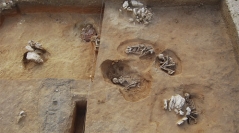

 Comptes Rendus Palevol
14 (2) - Pages 147-161
Comptes Rendus Palevol
14 (2) - Pages 147-161The archaeological excavations carried out between August 2007 and July 2008 in the necropolis of Campo de Hockey (transit Vth–IVth millennium BC) documented levels and structures of interest. We report the first data on the grave goods study, with a special focus on the “funerary” as social work investment. The correlations between the “grave goods” (such as social prestige values) and funerary structures can be established. The individual, double or triple characters of these burials imply social effort and sometimes involve an investment of community work. In the study of the necropolis, it has been observed that very few tombs have grave goods elements; this finding is of great interest because it confirms that incipient hierarchisation processes occurred in these Neolithic societies of South Iberia. We emphasise the analysis of so-called exotic products (amber, turquoise, variscite, sillimanite, etc.) as indicators of inequality, focusing on the correspondence between them and the most monumental or complex structures. We also note the importance of the exploitation of marine resources, which is obvious given the insular nature of the settlement, not only for food but also for ornamental purposes.
Neolithic, Necropolis, Exotic products, Variscite-turquoise, Amber, Social hierarchical organisation, Southwest Europe